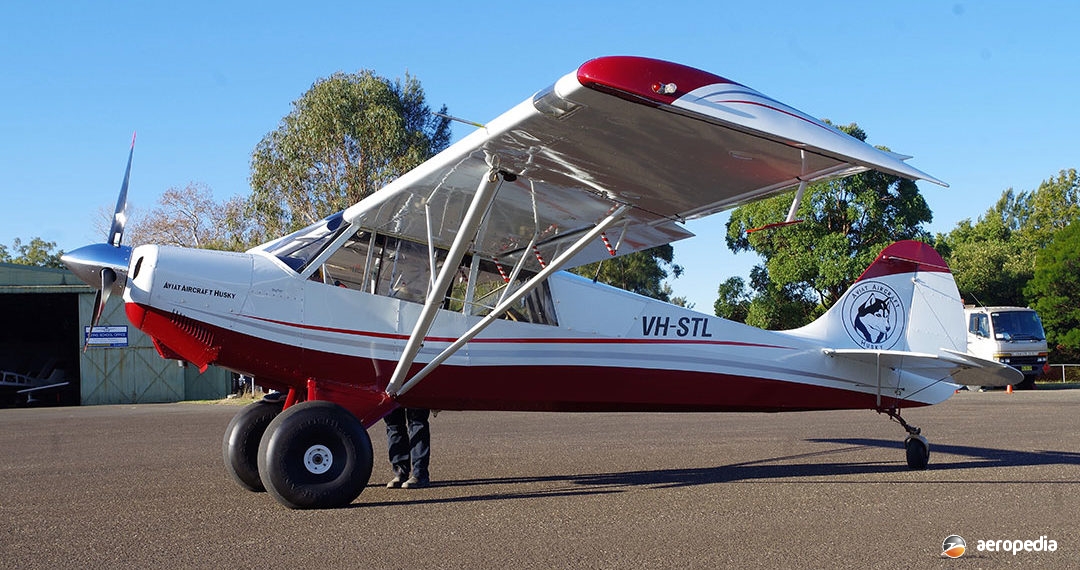Photograph:
Christen Husky VH-STL (c/n 1083) at Camden, NSW in June 2016 (David C Eyre)
Country of origin:
United States of America
Description:
Two-seat touring and training aircraft
Power Plant:
One 134 kw (180 hp) Avco Lycoming O-360-C16 four-cylinder horizontally-opposed air-cooled engine
Specifications:
- Wingspan: 10.75 m (35 ft 3 in)
- Length: 6.88 m (22 ft 6 in)
- Height: 2 m (6 ft 6 in)
- Wing area: 17 m² (183 sq ft)
- Max speed: 233 km/h (145 mph)
- Cruising speed at 75% power: 225 km/h (140 mph)
- Stalling speed power: 53 km/h (33 mph)
- Rate of climb: 457 m/min (1,500 ft/min)
- Service ceiling: 6,100 m (20,000 ft)
- Range at 55% cruise power: 1,287 km (800 miles)
- Empty weight: 533 kg (1,175 lb)
- Loaded weight: 816 kg (1,799 lb)
History:
The Christen Husky was a development of the Piper Super Cub produced by Aviat Inc of Wyoming, USA. Designed to FAR 23 standards, and certified in 1987, it was powered by a 134 kw (180 hp) Lycoming engine driving a constant-speed propeller, this giving superior performance to that previously available with the 112 kw (150 hp) engine. When first released to the market it was known as the Christen Husky, but later became known as the Aviat AA-1 Husky.
Construction was of welded steel tube with polyester fabric covering, the forward fuselage being all-metal covered. Produced on a production line alongside the Pitts Special, it was offered with a range of equipment including an IFR cockpit, floats, skis and tundra tyres. Take-off distance was 45.7 m (150 ft) and landing distance was 76.2 m (250 ft).
A small number have been imported to Australia, the first being VH-JIE (c/n 1137) in January 1992 based at Goulburn NSW; followed in April 1996 by VH-MUU (c/n 1304) and VH-WOF (c/n 1303), both registered in Queensland. A further example was registered in May 2006 as VH-STL (c/n 1083 – ex 9M-BDF, N2927R).
In Kenya the Wildlife Service has used the type to fight illegal ivory poaching, and for surveillance of elephant herds, for which its high-mounted wing and slow-flying characteristics made it ideally suited.
Production of the type continued and in later years Aviat announced a new model known as the Husky CNG, this model being able to be powered by compressed natural gas and Avgas at the flip of a switch. The prototype (N15NG) was a standard Husky A1-C which had been fitted with a CNG fuel tank with a capacity of 189 litres (41.6 Imp gals) in addition to the standard fuel tanks. It was powered by a 149 kw (200 hp) Lycoming engine, cruised at 222 km/h (138 mph) and had an endurance at 65 per cent power of seven hours.
Production of the type has continued as the Aviat Husky and models available have been the A-1 with a 134 kw (180 hp) Textron Lycoming O-360 engine or O-360-C1G with a gross weight of 816 kg (1,799 lb); the A-1A and A-1B certified on 28 January 1998 with the Lycoming O-360-A1P engine but which could also be fitted with the Lycoming IO-A1D6 engine of 150 kw (200 hp) and an MTV-15-B/205-58 propeller; the A-1B-160 Pup initially without and later with flaps with a Lycoming O-320-D2A engine of 119 kw (160 hp), a gross weight of 907 kg (2,000 lb) and a useful load of 352 kg (776 lb); the A-1C-180 and the A-1C-200, both certified in 2007, the latter having the Lycoming IO-360-A1D6 engine, a gross weight of 998 kg (2,200 lb) and a useful load of 399 kg (880 lb).

